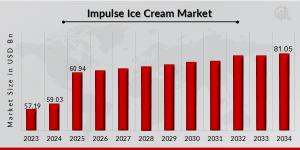Impulse Ice Cream Market to Reach 81.05 USD Billion by 2034 with 3.2% CAGR Driven by increasing consumer demand
Impulse Ice Cream Market Research Report By Flavor, Packaging, Distribution Channel, Price Range, Regional
NEW YORK, NY, UNITED STATES, April 29, 2025 /EINPresswire.com/ --Impulse Ice Cream Industry offers a comprehensive analysis of the industry’s current landscape, covering key factors such as flavor innovations, packaging formats, distribution channels, price segments, and regional dynamics. As consumer lifestyles continue to evolve and demand for convenient, on-the-go indulgences rises, the impulse ice cream sector is experiencing notable expansion across global markets.
Impulse Ice Cream Market was valued at approximately USD 59.03 billion in 2024. It is projected to grow from USD 60.94 billion in 2025 to USD 81.05 billion by 2034. The market is expected to register a compound annual growth rate (CAGR) of around 3.2% during the forecast period from 2025 to 2034.
Key Players:
Baskin Robbins, Fonterra, FrieslandCampina, Unilever, Haagen-Dazs, Lotte Confectionery, Mars, Ben Jerry’s, Meiji Dairies Corporation, Mondelez International, PepsiCo (Frito-Lay), Danone, Nestlé, Arla Foods
"Request Free Sample" - Obtain a complimentary sample of our report to assess its quality and relevance to your requirements: https://www.marketresearchfuture.com/sample_request/27068
Industry Overview and Developments
Impulse ice cream, defined by its spontaneous, single-serve purchases, remains a highly resilient sector within the broader frozen desserts industry. With a diverse array of offerings—ranging from traditional cones and bars to creative novelties—the market is adapting rapidly to shifting consumer preferences. Major players are investing in product innovation, eco-friendly packaging, and digital transformation to meet growing demand across all demographics. The market has witnessed an influx of dairy-free, low-sugar, and organic varieties, targeting health-conscious consumers without compromising the classic indulgent experience.
Strategic partnerships, celebrity endorsements, and social media marketing have further accelerated brand visibility and loyalty. Manufacturers are increasingly collaborating with retail giants and e-commerce platforms to streamline product availability and create targeted marketing campaigns that capitalize on the impulse-driven nature of ice cream purchases. Meanwhile, advancements in cold chain logistics and sustainable packaging technologies are reshaping supply chains, reducing environmental impact, and enhancing product quality from production to point of sale.
Flavor Trends Driving Market Growth
According to the report, flavor remains a primary driver influencing impulse ice cream purchases. Traditional favorites such as vanilla, chocolate, and strawberry continue to dominate sales globally, owing to their widespread appeal and nostalgic value. However, the market is also witnessing a surge in demand for innovative and exotic flavors like cookies and cream, mint, matcha, salted caramel, and tropical fruit blends.
Consumers today are eager to explore new taste experiences, particularly those that offer a fusion of cultures and artisanal craftsmanship. Limited-edition releases, seasonal flavors, and collaborations with well-known candy and cookie brands are fueling repeat purchases and brand engagement. The rising popularity of functional ingredients—such as added probiotics, vitamins, and adaptogens—is also creating opportunities for flavor innovation in premium product lines.
"Proceed to Buy" - Move forward with your purchase and gain instant access to the complete report: https://www.marketresearchfuture.com/checkout?currency=one_user-USD&report_id=27068
Packaging Formats Catering to Convenience and Sustainability
Packaging plays a pivotal role in the impulse ice cream market, balancing convenience, portion control, and sustainability. The report segments the packaging landscape into cones, cups, bars, and novelties. Cones and bars maintain strong consumer preference due to their portability and nostalgic appeal, while cups are gaining traction for their versatility and perceived portion control.
In response to growing environmental concerns, brands are prioritizing eco-friendly packaging options such as compostable wrappers, recyclable materials, and reduced-plastic designs. Innovations like edible packaging and reusable ice cream containers are slowly emerging, especially in premium and boutique brands. Brands that successfully align their packaging strategies with consumer expectations around convenience, aesthetics, and sustainability are poised to achieve long-term loyalty and competitive differentiation.
Distribution Channels Reflecting Modern Consumer Behavior
The impulse ice cream market is distributed through a mix of mass merchandisers, grocery stores, convenience stores, and online retailers. Mass merchandisers and grocery stores continue to be the dominant channels, offering consumers an extensive variety of choices and frequent promotions. Convenience stores thrive on the true "impulse" nature of purchases, with strategic placements near checkout areas and high-traffic zones.
Online retailers and direct-to-consumer models have experienced rapid growth, particularly in the aftermath of the COVID-19 pandemic, when contactless shopping became the norm. Subscription boxes, on-demand delivery apps, and exclusive online launches are redefining how consumers discover and purchase impulse ice cream. Brands that optimize their omnichannel strategies—ensuring seamless experiences across physical and digital touchpoints—are gaining significant market share.
Price Segments Responding to Diverse Consumer Demands
The impulse ice cream market is strategically segmented by price range into budget, mid-range, and premium categories. Budget products cater to cost-conscious consumers seeking affordable indulgence, often dominating mass markets and discount retailers. Mid-range offerings strike a balance between quality and affordability, appealing to a broad demographic, including families and young professionals.
The premium segment is witnessing particularly strong growth, driven by rising disposable incomes, a growing appetite for artisanal and organic products, and increased consumer willingness to spend on self-care and luxury experiences. Premium impulse ice creams often feature high-quality ingredients, ethical sourcing, creative branding, and limited-edition releases, differentiating themselves in an increasingly crowded marketplace.
Regional Insights Highlight Emerging Opportunities
Regionally, the report identifies North America and Europe as mature markets with established brand loyalty and consistent demand for innovative products. In North America, strong household brand recognition, combined with a culture of snacking and indulgence, continues to drive robust sales. Europe, with its deep-rooted culinary traditions and premiumization trends, shows a growing appetite for organic and sustainably produced ice creams.
Asia Pacific stands out as the fastest-growing regional market, fueled by rising urbanization, expanding middle-class populations, and increasing Western influence on food culture. Japan, South Korea, China, and India are key markets where premiumization and flavor experimentation are rapidly evolving. In South America, Brazil and Argentina show promising growth, propelled by youthful populations and expanding retail networks. Meanwhile, the Middle East and Africa are emerging as nascent markets, with potential for substantial growth as cold chain infrastructure and disposable incomes improve.
Market Drivers Powering Growth
Several factors are propelling the impulse ice cream market forward. Foremost is the ongoing trend of convenience-driven snacking, with busy lifestyles creating a strong demand for portable, quick indulgences. Increased urbanization, rising disposable incomes, and evolving consumer tastes contribute significantly to market expansion.
Technological advancements in production and storage, alongside improved cold chain logistics, ensure product quality and wider market penetration. Marketing campaigns that emphasize personalization, nostalgia, and experiential consumption are resonating particularly well with younger demographics, especially Millennials and Gen Z consumers. Moreover, a growing focus on health and wellness is driving innovation in better-for-you ice cream options, from dairy-free to low-calorie varieties.
"Browse Report" - Explore the report's contents, sections, and key insights by browsing through its detailed information: https://www.marketresearchfuture.com/reports/impulse-ice-cream-market-27068
Challenges Impacting Market Growth
Despite its vibrant outlook, the impulse ice cream market faces notable challenges. Seasonal dependence remains a key issue, with sales peaking during warmer months and declining during colder seasons in many regions. Volatility in raw material prices—such as dairy, cocoa, and sugar—also poses profitability risks for manufacturers.
Intense competition from private labels and emerging artisanal brands puts pressure on established players to consistently innovate and differentiate. Supply chain disruptions, particularly those affecting cold storage and transportation, can compromise product quality and availability. Furthermore, growing environmental concerns around packaging waste necessitate urgent investments in sustainable solutions, which can increase production costs.
Health-conscious consumers are scrutinizing ingredient lists more closely, and the perception of ice cream as an indulgent, high-calorie treat can act as a barrier to consumption among certain demographics. Brands must navigate these challenges by offering transparency, healthier options, and environmental stewardship without compromising on taste and experience.
TABLE OF CONTENTS:
1 EXECUTIVE SUMMARY
2 MARKET INTRODUCTION
3 RESEARCH METHODOLOGY
4 MARKET DYNAMICS
5 MARKET FACTOR ANALYSIS
6 IMPULSE ICE CREAM MARKET, BY FORM
7 IMPULSE ICE CREAM MARKET, BY CATEGORY
8 IMPULSE ICE CREAM MARKET, BY APPLICATION
9 IMPULSE ICE CREAM, BY REGION
10 COMPETITIVE LANDSCAPE
Discover more Research Reports on Food, Beverages & Nutrition Industry, by Market Research Future:
drum to hopper blends premix Market : https://www.marketresearchfuture.com/reports/drum-to-hopper-blends-premix-market-37709
dry blended product Market : https://www.marketresearchfuture.com/reports/dry-blended-product-market-37716
praline Market : https://www.marketresearchfuture.com/reports/praline-market-37718
prebiotic coffee Market : https://www.marketresearchfuture.com/reports/prebiotic-coffee-market-37611
pregnancy snack Market : https://www.marketresearchfuture.com/reports/pregnancy-snack-market-37692
premix bread flour Market : https://www.marketresearchfuture.com/reports/premix-bread-flour-market-37708
pressurized wine filter system Market : https://www.marketresearchfuture.com/reports/pressurized-wine-filter-system-market-37712About Market Research Future:
Market Research Future (MRFR) is a global market research company that takes pride in its services, offering a complete and accurate analysis with regard to diverse markets and consumers worldwide. Market Research Future has the distinguished objective of providing optimal quality research and granular research to clients. Our market research studies by products, services, technologies, applications, end users, and market players for global, regional, and country level market segments, enable our clients to see more, know more, and do more, which help answer your most important questions.
Contact Us:
Market Research Future (Part of Wantstats Research and Media Private Limited)
99 Hudson Street, 5Th Floor
New York, NY 10013
United States of America
+1 628 258 0071 (US)
+44 2035 002 764 (UK)
Email: sales@marketresearchfuture.com
Website: https://www.marketresearchfuture.com
Market Research Future
Market Research Future
+1 855-661-4441
email us here
Visit us on social media:
LinkedIn
Facebook
YouTube
X
Legal Disclaimer:
EIN Presswire provides this news content "as is" without warranty of any kind. We do not accept any responsibility or liability for the accuracy, content, images, videos, licenses, completeness, legality, or reliability of the information contained in this article. If you have any complaints or copyright issues related to this article, kindly contact the author above.
Gift Cards Market Set to Soar by 2035: In-Depth Analysis, Trends Across Type, Distribution, End Use, and Global Regions
Fame Tattoos Offers Nose Piercing Services to College Students in the Hialeah and Miami Area
City Suburb Inc. Offers Drywell Installation for Superior Stormwater Management
Kalendarium
Więcej ważnych informacji
 Jedynka Newserii
Jedynka Newserii

 Jedynka Newserii
Jedynka Newserii

Bankowość

Coraz mniej kredytów bankowych płynie do polskiej gospodarki. Przed sektorem duże wyzwania związane z finansowaniem strategicznych projektów
Polskie przedsiębiorstwa w coraz mniejszym stopniu finansują się kredytem bankowym, zwłaszcza w porównaniu z rosnącym PKB. Powoduje to wysoką nadpłynność sektora bankowego. Deregulacja mogłaby pomóc w skróceniu drogi firm do finansowania bankowego, zwłaszcza że Polskę czekają ogromne wydatki na transformację energetyczną i obronność. Sektor ma bardzo dobre wyniki finansowe, co powoduje, że politycy patrzą w stronę jego zysków. Ryzyko prawne, jakim wciąż są kredyty frankowe, pociąga za sobą brak zainteresowania ze strony zagranicznych inwestorów.
Firma
Bezrobocie może zacząć rosnąć. Ochłodzenie odczuwane szczególnie w branży budowlanej i automotive

W Polsce od kilku lat stopa bezrobocia utrzymuje się poniżej 6 proc., a według metodologii unijnej jest o połowę niższa i jedna z najniższych w Unii. Pracownicy przywykli już, że sytuacja na rynku pracy jest dla nich korzystna. Jednak zaczynają się pojawiać pierwsze niepokojące sygnały zwiastujące możliwą zmianę trendu. Część branż ucierpiała np. z powodu spowolnienia w Niemczech, inne rozważają wybór innej niż Polska lokalizacji ze względu na wysokie koszty pracy czy energii. Na razie ogromnym wyzwaniem pozostaje aktywizacja osób biernych zawodowo.
Ochrona środowiska
Rozwój sztucznej inteligencji drastycznie zwiększa zapotrzebowanie na energię. Rozwiązaniem są zrównoważone centra danych

Centra danych to jeden z dynamicznie rozwijających się, ale przy tym energochłonnych sektorów gospodarki. Prognozy PMR wskazują, że do 2030 roku operatorzy w Polsce będą dysponować centrami danych o mocy przekraczającej 500 MW, co oznacza, że wzrośnie ona ponad trzykrotnie względem 2024 roku. Przyspieszona cyfryzacja i dynamiczny rozwój sztucznej inteligencji sprawiają, że w ciągu kilku następnych lat zużycie energii elektrycznej w centrach danych tylko w Europie wzrośnie o 66 proc. Dlatego coraz więcej firm sięga po zrównoważone rozwiązania i energię pochodzącą ze źródeł odnawialnych.
Partner serwisu
Szkolenia

Akademia Newserii
Akademia Newserii to projekt, w ramach którego najlepsi polscy dziennikarze biznesowi, giełdowi oraz lifestylowi, a także szkoleniowcy z wieloletnim doświadczeniem dzielą się swoją wiedzą nt. pracy z mediami.



![Europejskie miasta planują wzrost inwestycji w infrastrukturę społeczną. Wydatki na niskoemisyjny transport wciąż są niewystarczające [DEPESZA]](https://www.newseria.pl/files/1097841585/panel-dotacje-foto,w_85,_small.jpg)





.gif)



